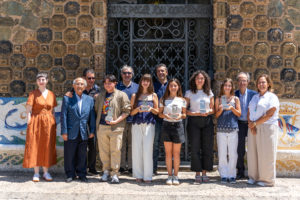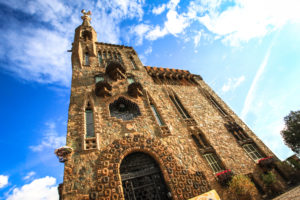What is Art Nouveau?
Art Nouveau, literally “new art” in French, is an artistic movement with origins that go back to the end of the 19th century, and whose development extended to the beginning of the 20th century, then reaching its peak .
The aim of this artistic current was to look for new forms, a modern art where even everyday objects had an aesthetic value, but without renouncing their pragmatic functions or industrial advances. It sought to reconcile utility and beauty.
Curved shapes inspired by nature and the use of historical or traditional elements with a modern approach (Neo-Gothic) are two main characteristics of Art Nouveau.
In Spain Art Nouveau was called “modernism”, it was applied mainly in architecture, Barcelona was the city where it had the greatest expression, and the architect Antoni Gaudí was its main exponent.
Barcelona: the city of Art Nouveau
Barcelona is, among the European capitals, one of the main exponents of Art Nouveau or modernism.
Modernist architecture can be found throughout the city, thanks to the work of architects such as Antoni Gaudí, author of many works that have come to be considered World Heritage by UNESCO. But there are also other illustrious modernist architects such as: Josep Puig i Cadafalch, Joan Rubió i Bellver, Jeroni Granell i Manresa or Lluís Domènech i Montaner, among others.
All of them left an indelible mark on Barcelona, in a period of time in which the city flourished in a cosmopolitan and modern atmosphere thanks to trade and industrial development. And it is that, between the end of the 19th and the beginning of the 20th, Barcelona had become a pioneering European capital in Art Nouveau with a multitude of works that today are an extraordinary artistic and architectural legacy, which is part of the famous modernist route of Barcelona.
Barcelona’s modernist route takes you through beautiful works that are benchmarks worldwide.
Palau de la Música Catalana
Designed by the architect Lluís Domènech i Montaner between 1905 and 1908, it is one of the best examples of Catalan modernism and Art Nouveau in all of Europe. It was built thanks to donations from different merchants and industrialists of the time and was declared a World Heritage Site by UNESCO in 1997.
Its facade with a preponderance of red brick color stands out, adorned with columns and mosaics. Inside we find elements such as the skylight in the ceiling of the platform, the lighting of large lanterns or the beautiful decorations carved in stone and with glass balusters.
Guided tours are available and it is a must for anyone who wants to discover Catalan modernism.
Casa Batlló
One of Antoni Gaudí’s best-known works, Casa Batlló, built between 1904 and 1906 on Passeig de Gràcia, is listed as a World Heritage Site.
It evokes the legend of Sant Jordi with a facade that recalls the scales of a dragon, with a predominance of curved shapes inspired by nature.
A magnificent work essential in the Modernist Route, which shines especially for Sant Jordi, in which the facade is dressed in red roses.
Torre Bellesguard
Another emblematic building by Antoni Gaudí, very unknown and with a lot of history, is Torre Bellesguard. It was built between 1900 and 1909 in the upper area of Barcelona, in a location that is by no means accidental.
The land on which Torre Bellesguard stands has been a witness and scene of the last two thousand years of history, with particular importance in the Middle Ages, when it was the royal residence of Martí I l’Humà, who was the last count of Barcelona.
This past of the estate greatly influenced Antoni Gaudí, who built a castle halfway between modernism and Gothic, in his particular version of Neo-Gothic. A unique architectural work, with a lot of symbolism and a lot of history, one of the works you cannot miss if you want to know who Antoni Gaudí was.
Casa Milà
Also known as “La Pedrera”, it was built between 1906 and 1910, with curved shapes throughout the facade that want to symbolize the waves of the sea.
One of the majestic buildings of Passeig de Gràcia and one of Antoni Gaudí’s great works, also listed as World Heritage.
Casa de les Punxes
Extraordinary work carried out by the architect Josep Puig i Cadafalch in 1905, inspired by medieval Gothic art.
Its six neo-Gothic towers topped with red, the brown and white colors of the facade and the floral decoration inspired by nature, so typical of Catalan Art Nouveau, stand out.
Palau Güell
One of Antoni Gaudí’s first works, it was inaugurated in 1888. Located a few meters from La Rambla, this iconic building is today a UNESCO World Heritage Site.
It belongs to Gaudí’s orientalist period, and highlights the use of oriental elements and Hispanic Islamic art such as the oval doors and the decorations inspired by Mudejar and Nassarite art.
Casa Lleó i Morera
Built in 1902 by the architect Lluís Domènech i Montaner, this building is considered one of this architect’s masterpieces.
Its facade stands out with a multitude of organic and floral decorative elements so characteristic of modernist art and its inspiration in nature.
Hospital de Santa Creu i de Sant Pau
Begun to be built by the architect Lluis Domènech i Montaner in 1902 and completed by his son in 1930, the Hospital de la Santa Creu i Sant Pau is listed as a UNESCO World Heritage Site.
It is a beautiful modernist complex heavily influenced by medieval and Moorish art. Its beauty lies in the contrasts between the red colors of the facades with the green and white tones and the yellow of the roofs.
Casa Macaya
Designed by the architect Josep Puig i Cadafalch, it is one of the best examples of his interpretation of Catalan modernism. It was built in 1898 and is an Asset of Cultural Interest. It stands out for its size and grandeur, as well as its magnificent interior patio.
La Sagrada Família
Antoni Gaudí’s great masterpiece: the Expiatory Temple of La Sagrada Família.
Inspired by Neo-Gothic art, it has become a symbol of the city of Barcelona and one of the most important and most visited modernist works worldwide.
The beginning of its construction dates from 1882 and it is expected that the works will end in 2026, coinciding with the centenary of the death of Antoni Gaudí.




